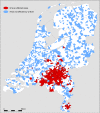Nationwide registry-based ecological analysis of Q fever incidence and pregnancy outcome during an outbreak in the Netherlands
- PMID: 25862010
- PMCID: PMC4401861
- DOI: 10.1136/bmjopen-2014-006821
Nationwide registry-based ecological analysis of Q fever incidence and pregnancy outcome during an outbreak in the Netherlands
Abstract
Objective: Whether areas affected by Q fever during a large outbreak (2008-2010) had higher rates of adverse pregnancy outcomes than areas not affected by Q fever.
Design: Nationwide registry-based ecological study.
Setting: Pregnant women in areas affected and not affected by Q fever in the Netherlands, 2003-2004 and 2008-2010.
Participants: Index group (N=58,737): pregnant women in 307 areas with more than two Q fever notifications. Reference group (N=310,635): pregnant women in 921 areas without Q fever notifications. As a baseline, pregnant women in index and reference areas in the years 2003-2004 were also included in the reference group to estimate the effect of Q fever in 2008-2010, and not the already existing differences before the outbreak.
Main outcome measures: Preterm delivery, small for gestational age, perinatal mortality.
Results: In 2008-2010, there was no association between residing in a Q fever-affected area and both preterm delivery (adjusted OR 1.01 (95% CI 0.94 to 1.08)), and perinatal mortality (adjusted OR 0.87 (95% CI 0.72 to 1.05)). In contrast, we found a weak significant association between residing in a Q fever-affected area in 2008-2010 and small for gestational age (adjusted OR 1.06 (95% CI 1.01 to 1.12)), with a population-attributable fraction of 0.70% (95% CI 0.07% to 1.34%). We observed no dose-response relation for this outcome with increasing Q fever notifications, and we did not find a stronger association for women who were in their first trimester of pregnancy during the months of high human Q fever incidence.
Conclusions: This study found a weak association between residing in a Q fever-affected area and the pregnancy outcome small for gestational age. Early detection of infection would require mass screening of pregnant women; this does not seem to be justified considering these results, and the uncertainties about its efficacy and the adverse effects of antibiotic treatment.
Keywords: Epidemiology < INFECTIOUS DISEASES; OBSTETRICS; Public health < INFECTIOUS DISEASES.
Published by the BMJ Publishing Group Limited. For permission to use (where not already granted under a licence) please go to http://group.bmj.com/group/rights-licensing/permissions.
Figures
Similar articles
-
Cost-effectiveness of a screening strategy for Q fever among pregnant women in risk areas: a clustered randomized controlled trial.BMC Womens Health. 2010 Nov 1;10:32. doi: 10.1186/1472-6874-10-32. BMC Womens Health. 2010. PMID: 21040534 Free PMC article. Clinical Trial.
-
Antibodies against Coxiella burnetii and pregnancy outcome during the 2007-2008 Q fever outbreaks in The Netherlands.BMC Infect Dis. 2011 Feb 11;11:44. doi: 10.1186/1471-2334-11-44. BMC Infect Dis. 2011. PMID: 21314933 Free PMC article.
-
Outcomes of Pregnancies for Women Undergoing Endoscopy While They Were Pregnant: A Nationwide Cohort Study.Gastroenterology. 2017 Feb;152(3):554-563.e9. doi: 10.1053/j.gastro.2016.10.016. Epub 2016 Oct 20. Gastroenterology. 2017. PMID: 27773807
-
Q fever in the Netherlands - 2007-2010: what we learned from the largest outbreak ever.Med Mal Infect. 2014 Aug;44(8):339-53. doi: 10.1016/j.medmal.2014.02.006. Epub 2014 Aug 6. Med Mal Infect. 2014. PMID: 25108615 Review.
-
Q fever in the Netherlands: a concise overview and implications of the largest ongoing outbreak.Neth J Med. 2008 Oct;66(9):365-7. Neth J Med. 2008. PMID: 18931396 Review.
Cited by
-
From Q Fever to Coxiella burnetii Infection: a Paradigm Change.Clin Microbiol Rev. 2017 Jan;30(1):115-190. doi: 10.1128/CMR.00045-16. Clin Microbiol Rev. 2017. PMID: 27856520 Free PMC article. Review.
-
Clinical Features and Complications of Coxiella burnetii Infections From the French National Reference Center for Q Fever.JAMA Netw Open. 2018 Aug 3;1(4):e181580. doi: 10.1001/jamanetworkopen.2018.1580. JAMA Netw Open. 2018. PMID: 30646123 Free PMC article.
-
Pregnancy outcomes of Q fever: prospective follow-up study on Reunion island.BMC Infect Dis. 2019 Nov 27;19(1):1001. doi: 10.1186/s12879-019-4619-6. BMC Infect Dis. 2019. PMID: 31775645 Free PMC article.
-
Serological Prevalence of and Risk Factors for Coxiella burnetti Infection in Women of Punjab Province, Pakistan.Int J Environ Res Public Health. 2022 Apr 11;19(8):4576. doi: 10.3390/ijerph19084576. Int J Environ Res Public Health. 2022. PMID: 35457443 Free PMC article.
-
Seroprevalence of Q fever in cattle, sheep and goats in the Volta region of Ghana.Vet Med Sci. 2019 Aug;5(3):402-411. doi: 10.1002/vms3.160. Epub 2019 Mar 11. Vet Med Sci. 2019. PMID: 30859744 Free PMC article.
References
Publication types
MeSH terms
LinkOut - more resources
Full Text Sources
Other Literature Sources
Medical
Research Materials

